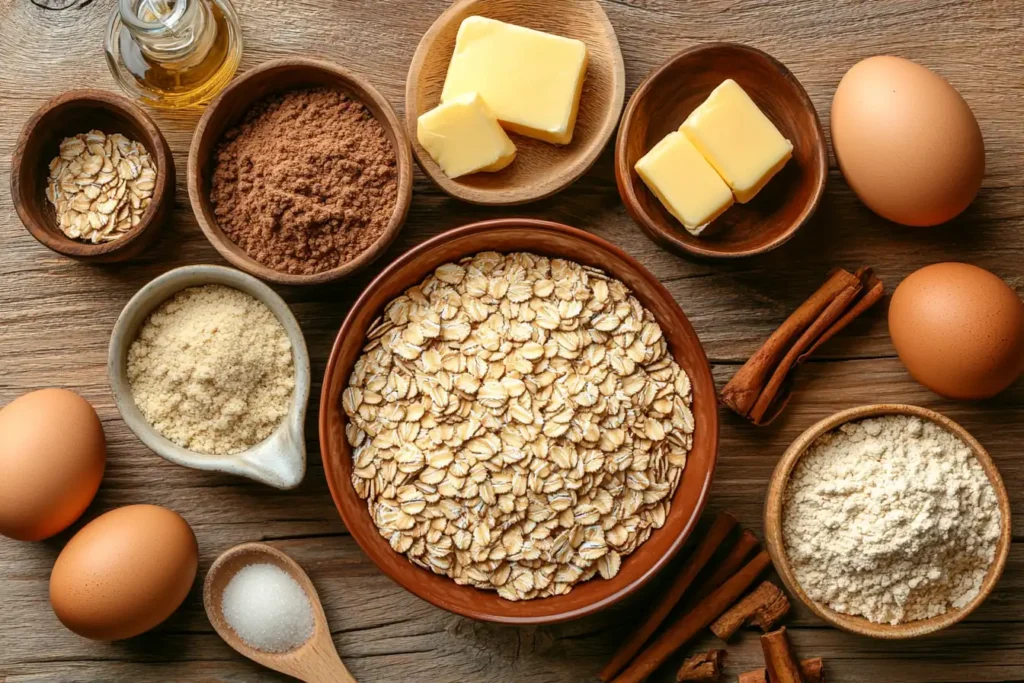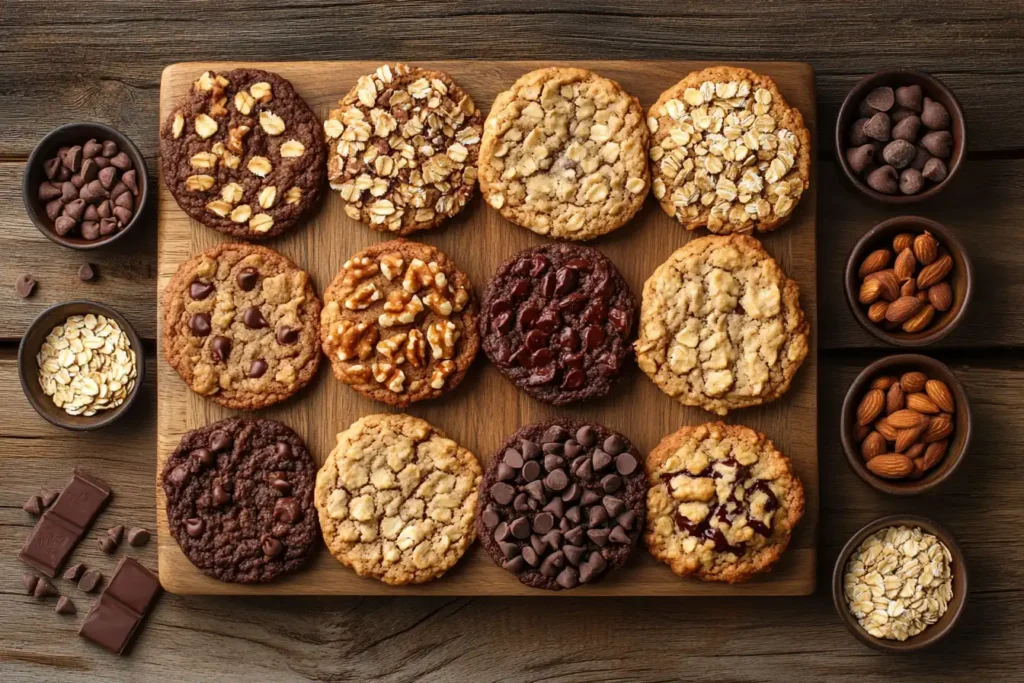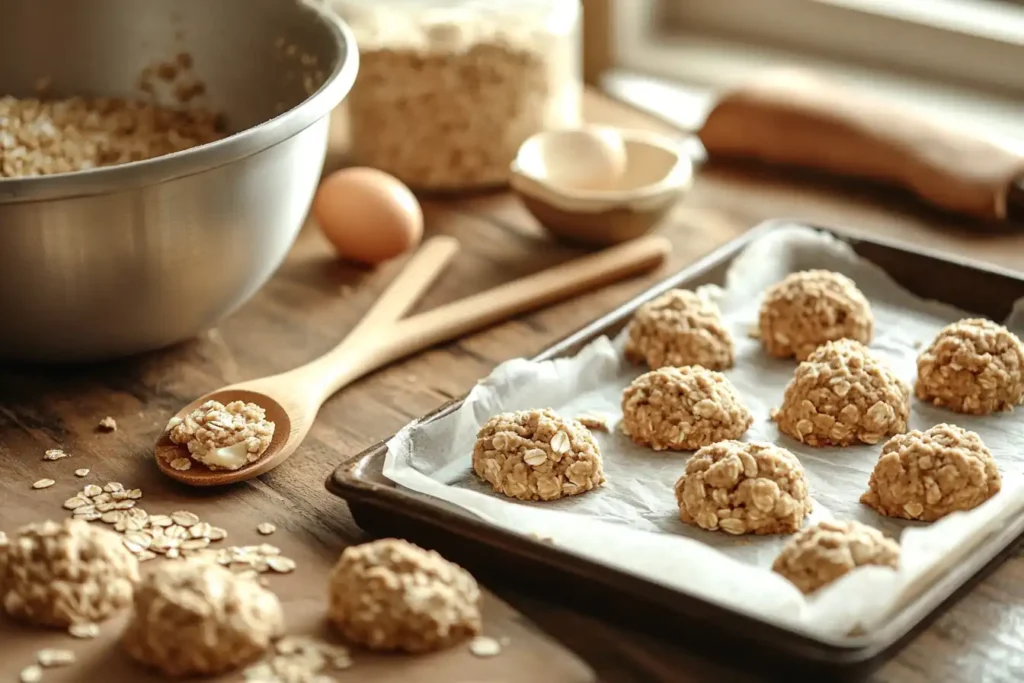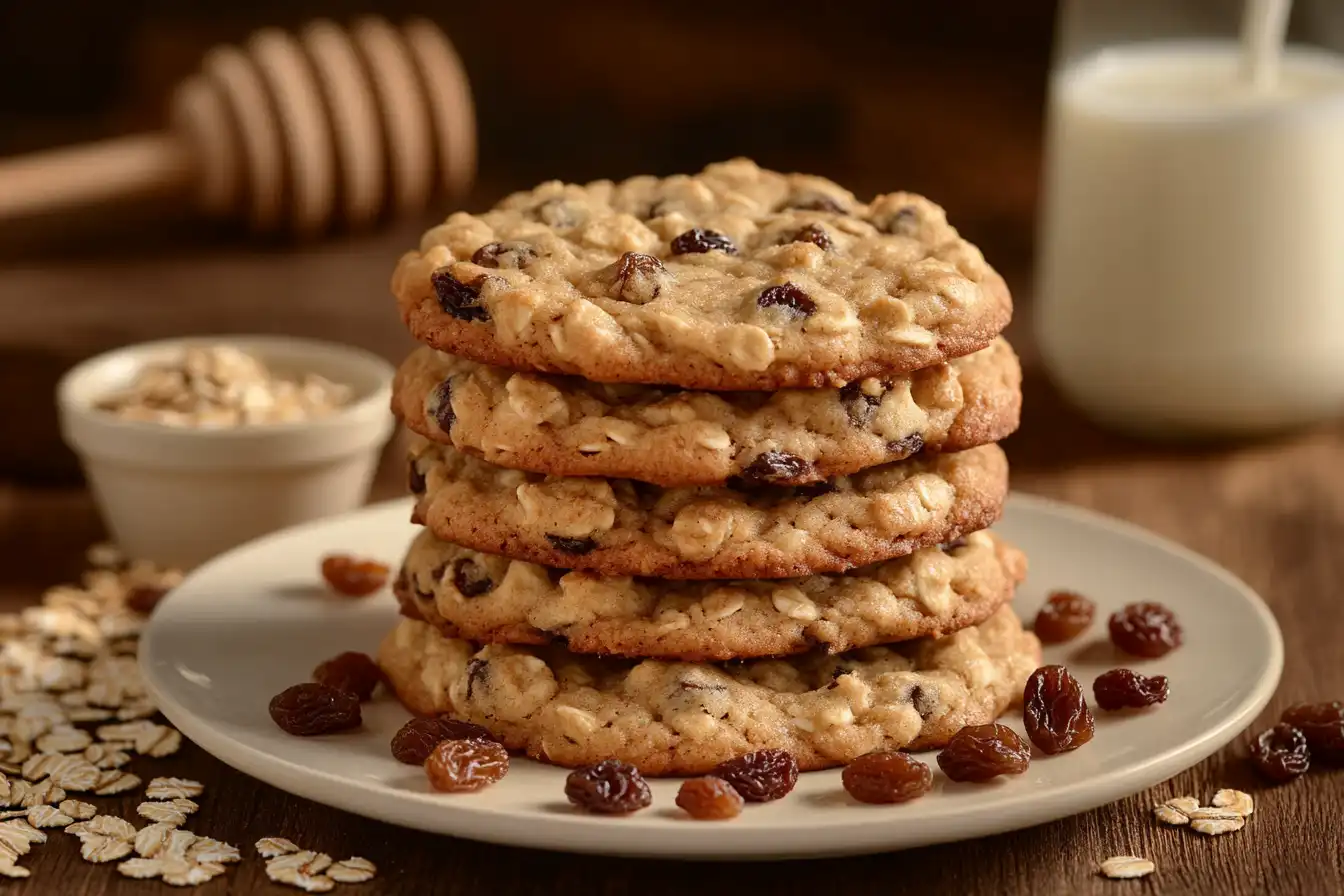Craving a sweet treat that’s as wholesome as it is delicious? Look no further than the Quaker oatmeal cookie recipe. Packed with the nutty goodness of oats and a touch of sweetness, these cookies are a timeless favorite. In this ultimate guide, we’ll explore the classic recipe, delve into its variations, share baking tips, and answer your pressing cookie-related questions. Whether you’re aiming for chewy or crispy, you’re bound to uncover the secrets to baking perfection. Let’s dive in!
Introduction to Quaker Oatmeal Cookies
Few desserts bring as much comfort as the humble oatmeal cookie. Combining simplicity with unmatched flavor, these cookies have a unique charm. With their iconic blend of rolled oats, butter, and sugar, they’ve become a global favorite. The Quaker oatmeal cookie recipe stands out for its reliability and versatility, making it a go-to for seasoned bakers and beginners alike. But where did it all start?
A Brief History of Quaker Oats
Quaker Oats has been a staple in American kitchens for over a century, dating back to 1877. Moreover, as one of the first brands to introduce rolled oats to the mass market, Quaker made it easy for families to enjoy oats in various forms, from hearty breakfasts to indulgent desserts. In fact, the company’s oatmeal cookie recipe became a household treasure in the mid-20th century, featured on the back of its oatmeal packaging. Even today, it remains a beloved classic, often passed down through generations.
Popularity of Oatmeal Cookies
Why are oatmeal cookies so popular? Well, it’s all about their delightful balance of taste and texture. For instance, the chewy, slightly nutty flavor of oats pairs beautifully with the sweetness of brown sugar and the rich creaminess of butter. Additionally, versatility plays a significant role—you can add raisins, chocolate chips, or even spices to create your signature version. Furthermore, oatmeal cookies offer a touch of nostalgia, reminding many of warm kitchens and childhood memories. Indeed, no wonder they’ve stood the test of time!
The Original Quaker Oatmeal Cookie Recipe
The original Quaker oatmeal cookie recipe has stood the test of time, offering a delicious combination of simplicity and taste. With a perfect balance of sweetness, texture, and wholesome oats, this recipe creates cookies that are not just a treat but also a nostalgic bite of history. Let’s break it down step-by-step, starting with the ingredients that make these cookies shine.
Ingredients Overview

To craft the perfect batch of Quaker oatmeal cookies, you’ll need some pantry staples and a few fresh essentials:
- Old-fashioned oats: The star ingredient, providing chewiness and a nutty flavor.
- Unsalted butter: For a rich, creamy texture.
- Brown sugar: Adds moisture and a deep caramel flavor.
- Granulated sugar: Balances the sweetness.
- All-purpose flour: Creates structure for the cookies.
- Eggs: Bind everything together.
- Baking soda: Ensures the cookies rise perfectly.
- Vanilla extract: Enhances the overall flavor.
- Optional add-ins: Raisins, chocolate chips, or nuts for a personalized touch.
Each ingredient plays a crucial role in achieving that delightful combination of chewy centers and crispy edges.
Step-by-Step Preparation
Follow these simple steps to make your own batch of cookies:
- Prepare the dough: In a large bowl, cream butter and sugars until fluffy. Add eggs and vanilla extract, mixing until well combined.
- Combine dry ingredients: In a separate bowl, whisk together flour, baking soda, and salt. Gradually add to the wet ingredients, mixing just until combined.
- Add oats and extras: Fold in oats and your choice of add-ins. The dough should be slightly sticky.
- Shape and bake: Scoop dough onto a parchment-lined baking sheet, spacing them evenly. Bake at 350°F (175°C) for 10-12 minutes or until golden brown.
Let the cookies cool slightly before enjoying—they’re irresistible!
Nutritional Information
Quaker oatmeal cookies aren’t just delicious—they also offer nutritional benefits thanks to the wholesome oats. While they’re a sweet indulgence, understanding their calorie content and nutritional highlights can help you enjoy them mindfully.
Calorie Content
On average, one Quaker oatmeal cookie contains about 100-120 calories, depending on the size and additional ingredients. Specifically, these calories primarily come from oats, butter, and sugar. However, for a lighter version, you can adjust the recipe by reducing sugar or substituting with natural sweeteners like honey or applesauce. As a result, you can enjoy a slightly healthier treat without compromising too much on flavor.
Health Benefits of Oats
Oats are the unsung heroes of this recipe, offering:
- Fiber: Helps with digestion and promotes a feeling of fullness.
- Beta-glucan: A type of soluble fiber that supports heart health by lowering cholesterol.
- Energy: Provides slow-releasing carbohydrates for sustained energy.
Including oats in your desserts not only enhances the flavor but also boosts the nutritional profile, making these cookies a guilt-free treat when enjoyed in moderation.
Variations of the Quaker Oatmeal Cookie
The Quaker oatmeal cookie recipe is beloved for its versatility. With just a few tweaks, you can create endless variations to suit any taste or dietary preference.

Oatmeal Raisin Cookies
Oatmeal raisin cookies are a classic favorite, blending the chewy texture of oats with the natural sweetness of raisins. To make them, simply fold a generous handful of raisins into the dough before baking. The raisins plump up during baking, adding bursts of fruity flavor. This variation is perfect for those seeking a nostalgic treat or a touch of wholesome sweetness.
Oatmeal Chocolate Chip Cookies
For chocolate lovers, oatmeal chocolate chip cookies truly hit the spot. To enhance the flavor, replace or combine raisins with semi-sweet chocolate chips for a richer, more indulgent taste. In addition, the melted chocolate balances the oats’ nuttiness, making these cookies absolutely irresistible. Moreover, a sprinkle of sea salt on top adds a gourmet touch, elevating them to the next level!
Oatmeal Nut Cookies
Add some crunch to your cookies by including nuts like walnuts, pecans, or almonds. Chop them finely or leave them chunky for added texture. Nuts not only enhance the flavor but also provide a dose of healthy fats, making this variation both tasty and nutritious.
Gluten-Free Oatmeal Cookies
Need a gluten-free option? Swap out all-purpose flour for a gluten-free baking mix or almond flour. Ensure the oats are certified gluten-free to avoid cross-contamination. The result is a deliciously chewy cookie that everyone can enjoy without compromising on flavor.
Creative Add-ins and Toppings
Unleash your creativity by experimenting with unique ingredients that elevate your Quaker oatmeal cookies to new heights. You can even try adding cottage cheese for a healthier and protein-packed twist. Curious about this option? Explore this Cottage Cheese Cookie Dough recipe for inspiration—it’s a great way to innovate while maintaining the deliciousness of classic cookies!
Dried Fruits
Beyond raisins, try adding dried cranberries, apricots, or cherries. These fruits introduce a tangy, sweet twist that complements the oats beautifully. Chop them into small pieces for even distribution throughout the dough.
Nuts and Seeds
Incorporate seeds like chia, flax, or sunflower seeds for a nutritious boost. Pair them with nuts for a hearty, satisfying texture. This combination makes the cookies feel more substantial, perfect for a quick snack.
Spices and Flavorings
Enhance your cookies with warm spices like cinnamon, nutmeg, or cardamom. A dash of these spices can transform the flavor profile into something more aromatic and festive. Add a splash of almond or maple extract for an extra layer of flavor that’s sure to impress.
Baking Tips and Techniques
Getting the texture right is what sets great cookies apart from the rest. Whether you prefer chewy centers or crispy edges, small adjustments in the Quaker oatmeal cookie recipe can make all the difference.

Chewy vs. Crispy Cookies
For chewy cookies, focus on moisture. Use more brown sugar than white sugar because it retains more moisture, and don’t overbake them. Adding an extra egg yolk can also contribute to a softer texture. Letting the dough chill for at least 30 minutes before baking allows the oats to absorb the liquid, enhancing chewiness.
To achieve crispy cookies, bake them a little longer and at a slightly lower temperature, around 325°F (165°C). Spread the dough thinner on the baking sheet, and use more granulated sugar, as it encourages a crisp texture. A dash of butter melted into the mix can also help make the edges irresistibly crunchy.
Baking Time and Temperature
Baking oatmeal cookies at the right temperature is key to their success. Stick to the recommended 350°F (175°C) for a balanced texture, but adjust the time based on your preferences. For chewy cookies, bake for 8-10 minutes, just until the edges are lightly golden. For crispy cookies, leave them in for 12-14 minutes.
Always use a preheated oven to ensure even cooking, and bake one tray at a time in the center rack. If using a convection oven, reduce the temperature by 25°F (about 15°C) to prevent over-browning. Keep an eye on the first batch to fine-tune your timing for perfect results.
Common Mistakes to Avoid
Even the best recipe can falter if common baking pitfalls aren’t avoided. Here’s how to sidestep two of the most frequent issues bakers face with oatmeal cookies.
Overmixing the Dough
It’s tempting to mix your cookie dough thoroughly, but overmixing activates the gluten in the flour, leading to tougher cookies. Once you add the dry ingredients to the wet mixture, mix only until just combined. This preserves the tender, crumbly texture oatmeal cookies are known for.
If you’re folding in oats or add-ins like raisins or chocolate chips, use a gentle hand. Overworking the dough at this stage can also lead to dense cookies that lack the soft, comforting texture you’re aiming for.
Incorrect Measurements
Baking is as much science as art, so accurate measurements are essential. Too much flour will make your cookies dry and crumbly, while too little will cause them to spread too much during baking. Always use a measuring cup designed for dry ingredients for flour and oats, and level it off with a straight edge.
For wet ingredients like butter or vanilla extract, use liquid measuring cups and read them at eye level. Investing in a kitchen scale can take the guesswork out of measurements, ensuring consistent and delicious results every time.
Serving Suggestions of Quaker Oatmeal Cookies
Quaker oatmeal cookies are delightful on their own, but pairing or incorporating them with other treats elevates the experience. Whether you’re serving them fresh out of the oven or creatively using them in other recipes, these cookies always shine.
Pairing with Beverages
Nothing beats the classic pairing of oatmeal cookies with a cold glass of milk. The creaminess of milk complements the chewy sweetness of the cookies perfectly. For a cozy vibe, pair them with a cup of hot cocoa or herbal tea. For coffee lovers, a latte or cappuccino adds just the right balance of bitter and sweet, enhancing the cookie’s warm flavors. These combinations make snack time or dessert extra special.
Incorporating into Desserts
Take your cookies to the next level by incorporating them into other desserts. Crumble them over a bowl of vanilla ice cream for a quick, irresistible sundae. Use them as a base for cheesecake or layer them into a trifle with whipped cream and fruit. You can even sandwich a dollop of cream cheese frosting or peanut butter between two cookies for a decadent treat.
Storage Guidelines
To enjoy your cookies at their best, proper storage is crucial. Whether you plan to savor them over a few days or save them for later, these tips will keep them fresh and delicious.
Room Temperature Storage
Store your oatmeal cookies in an airtight container at room temperature for up to a week. Adding a slice of bread to the container helps maintain moisture, keeping the cookies soft and chewy. For crispier cookies, avoid using bread and ensure the container is tightly sealed to prevent them from going stale.
Keep the container away from direct sunlight and heat sources to preserve their texture and flavor. If your cookies have any cream-based fillings, refrigerate them to ensure they stay safe to eat.
Freezing for Extended Freshness
For longer storage, freezing is your best option. Arrange cookies in a single layer on a baking sheet, freeze them until firm, and then transfer them to a freezer-safe bag or container. They’ll stay fresh for up to three months.
To enjoy, simply thaw the cookies at room temperature for 15-20 minutes or warm them in the oven for a freshly baked feel. Freezing the dough itself is another great option—just scoop out portions, freeze them, and bake as needed for fresh cookies anytime.
FAQs about Quaker Oatmeal Cookie Recipe
Here are answers to some common questions about the Quaker oatmeal cookie recipe. Whether you’re a beginner baker or a seasoned pro, these tips will help you perfect your cookies.
Why can’t you use instant oats in cookies?
Instant oats are too fine and cook too quickly, which affects the texture of your cookies. They can make the dough too dense and prevent the cookies from achieving the chewy, hearty texture that rolled oats provide. Stick with old-fashioned oats for the best results.
Is an oatmeal cookie healthier than a chocolate chip cookie?
Oatmeal cookies often have a slight edge in health benefits because of the oats, which provide fiber, beta-glucan, and essential nutrients. However, both cookies contain sugar and butter, so the overall nutritional difference depends on the recipe and portion size.
Can I use quick oats instead of rolled oats for cookies?
Yes, you can use quick oats, but they will slightly alter the texture. Quick oats are thinner and smaller, resulting in cookies that are less chewy and more uniform. For a traditional oatmeal cookie, rolled oats are the preferred choice.
Why are my oatmeal cookies always dry?
Dry cookies can result from overbaking or too much flour in the dough. To fix this, measure your ingredients accurately and bake the cookies until the edges are just golden. Adding an extra egg yolk or slightly increasing the butter can also boost moisture.
Can I use Quaker oats instead of rolled oats?
Yes, Quaker old-fashioned oats are ideal for oatmeal cookies. They provide the chewy texture and nutty flavor that make these cookies so irresistible. Just avoid using instant Quaker oats for the reasons mentioned earlier.
What kind of oatmeal is best for baking cookies?
Old-fashioned rolled oats are the best option for baking cookies. They hold their shape during baking and create a satisfying chewy texture. If you prefer a softer texture, quick oats can work, but avoid steel-cut oats, as they won’t soften enough in the baking process.
Conclusion
Quaker oatmeal cookies are more than just a dessert—they’re a connection to tradition, comfort, and creativity. Whether you follow the original Quaker oatmeal cookie recipe to the letter or experiment with your own twists, these cookies bring joy to any occasion. Their timeless appeal lies in their simplicity, versatility, and the wholesome goodness of oats.
Encouragement to Experiment with Recipes
Baking is as much about exploration as it is about following instructions. Don’t hesitate to put your own spin on the classic recipe. Add dried fruits, sprinkle in spices, or try out gluten-free or vegan variations. Each tweak is an opportunity to make these cookies uniquely yours. The best part? Every experiment results in a batch of delicious treats!
Final Thoughts on Baking at Home
Baking oatmeal cookies at home is a rewarding experience. From the soothing process of mixing ingredients to the irresistible aroma filling your kitchen, it’s a journey that delights the senses. With a little attention to detail and creativity, you can create cookies that are not only delicious but also packed with warmth and love. So preheat that oven, grab your ingredients, and let the baking magic begin!

